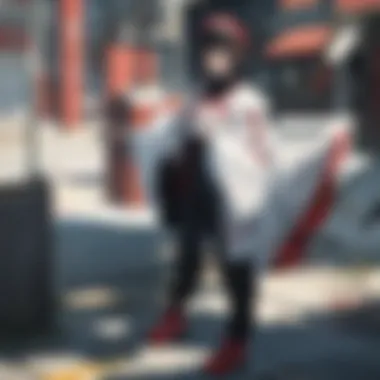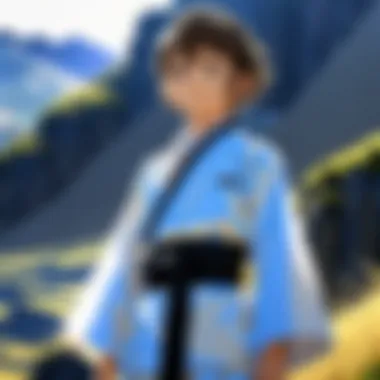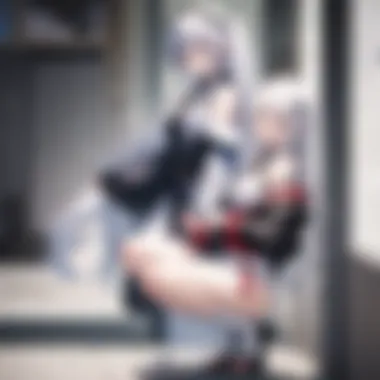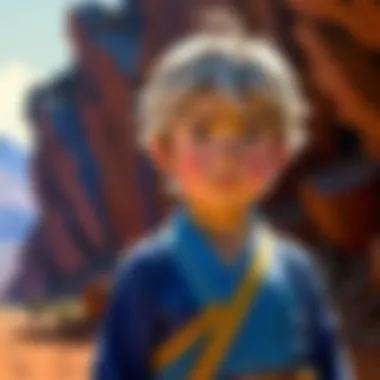Exploring Seita: War, Innocence, and Resilience


Intro
The exploration of character Seita from the film Grave of the Fireflies brings forth a complex understanding of his emotional and psychological landscape. The narrative reveals the devastating impacts of war on childhood innocence and familial relationships. Seita's journey is not merely a tale of survival; it is an intricate portrayal of loss, helplessness, and the struggle to maintain one’s humanity in the face of tragedy.
This article aims to dissect these multi-faceted elements of Seita's character through various lenses. By considering the narrative's role, character development, and sociocultural implications, we seek to distance ourselves from superficial interpretations. The examination of audience reception will also highlight how deeply Seita's character resonates and prompts reflection on broader themes.
Episode Reviews
Summary of the Episode
Grave of the Fireflies unfolds in a post-World War II Japan, spotlighting the harrowing experiences of Seita and his younger sister, Setsuko. The film chronicles their fight for survival amidst the ravages of war, showcasing how societal collapse affects even the most innocent lives. Seita's initial optimism gives way to profound despair as he grapples with the harsh realities of their existence.
Analysis of Key Events
Several pivotal moments shape Seita’s development throughout the film. His decision to abandon his mother's home marks a crucial turning point. This act signifies both a physical and emotional distancing from safety, reflecting an early misjudgment rooted in youthful pride.
The escalating struggle for resources, highlighted when Setsuko succumbs to starvation, deeply influences Seita's descent into guilt and despair. This tragic event epitomizes the consequences of war, as innocence is ravaged in the process.
Discussion on Character Development
Seita evolves from a hopeful child to a figure embodying desperation and regret. His character arc encapsulates a loss of innocence that mirrors the broader destruction wrought by war. The deterioration of his mental state becomes evident as he alienates himself from social bonds, contributing to a profound sense of isolation. These elements render Seita's experiences a reflection of the overarching theme of familial bonds in distress.
Highlight Memorable Moments
Certain moments in the film leave a lasting impact and reveal the depth of Seita's character:
- The Fireflies: The titular symbol represents fleeting moments of joy against a backdrop of sorrow.
- Setsuko's Illness: This event serves as a microcosm of Seita’s helplessness, amplifying the film’s emotional weight.
- Seita's Final Scene: The haunting conclusion highlights both the futility of his efforts and the fragility of life during wartime.
Character Spotlights
Background Information on the Character
Seita is a young boy grappling with the responsibilities of adulthood thrust upon him by the consequences of war. The depth of his character arises from his transition from childhood to a forced maturity in the wake of tragedy.
Personality Traits and Unique Quirks
Seita exhibits a mix of resilience and stubbornness. His protective nature towards Setsuko showcases his strong familial bonds but also hints at his ultimate downfalls, such as denial of help. His fervent love for his sister provides a glimpse into his emotional core, albeit overshadowed by his growing despair.
Role in the Storyline
Seita functions as both protagonist and tragic hero. His journey is central to the narrative and serves as a vehicle for exploring broader themes of loss, sacrifice, and the impact of war. The film uses his experiences to delve into the larger societal consequences of conflict.
Fan Theories and Speculations
Discussions among viewers often ponder the true symbolism of Seita’s journey. Some theories suggest that his character serves as a representation of lost potential in a war-torn society, while others posit that his choices reflect a struggle against a predestined fate, illuminating deeper philosophical implications.
Anime vs. Manga Comparison
The cinematic adaptation of Grave of the Fireflies is lauded for its emotional impact and visual storytelling.
- Plot Differences: The film condenses the original story, emphasizing key emotional beats while omitting minor character arcs.
- Art and Animation Quality: The art style of the movie serves to enhance the tragic tone, with detailed backgrounds that vividly capture the essence of post-war Japan.
- Character Portrayal: Both formats depict Seita's character profoundly, though the film's visual medium amplifies the emotional experience, often at the expense of narrative depth found in the manga.
- Fan Preferences and Opinions: Discussions around these formats reveal a tendency among fans to favor the emotional resonance of the film while appreciating the depth of storytelling in the manga.


Industry News and Updates
Recent discussions around anime and adaptation reveal trends related to remakes and evolving narratives. Industry professionals are increasingly recognizing the importance of faithful representations of character motivations and themes derived from original works.
Culmination
By examining Seita's character through various frameworks, we uncover layers of emotional complexity that resonate significantly within the context of war and childhood. This comprehensive analysis seeks to highlight the nuances that define Seita, emphasizing the need for a thoughtful and informed engagement with this profound narrative.
Prelude to Seita
Understanding Seita's character is crucial to grasp the broader themes in Grave of the Fireflies. His journey reflects not only personal struggles but also collective hardships faced during wartime. Through Seita, viewers can explore the psychological and emotional impact of war on children. Moreover, his character serves as a lens to examine notions of innocence, resilience, and familial bonds in dire circumstances.
Background of 'Grave of the Fireflies'
Grave of the Fireflies, directed by Isao Takahata, is a poignant animated film that depicts the tragic experiences of two siblings in Japan during World War II. The film provides a raw and harrowing look at the consequences of war. It vividly portrays the harsh realities faced by civilians, especially children. Seita and his sister, Setsuko, navigate through starvation, loss, and despair. The narrative stands as a stark reminder of the human cost of conflict. War is not just a backdrop; it shapes the characters’ lives, leading them to make difficult choices in search of survival.
Overview of Seita's Character
Seita is presented as a complex character, evolving throughout the film. Initially, he embodies the innocence of childhood, full of dreams and aspirations. However, as the storyline unfolds, the war's brutal effects significantly alter his demeanor. Seita's responsibilities grow under challenging conditions, compelling him to transition from a carefree boy to a protective older brother. His character encapsulates themes of loyalty and sacrifice. While he often tries to maintain hope, the circumstances increasingly erode his spirit. Ultimately, Seita personifies the tragic loss of innocence, serving as a conduit for the viewer's emotional experience. His struggles resonate with audiences, illuminating the broader ramifications of war.
Seita's Early Life
Understanding Seita's early life is crucial for grasping the emotional and psychological layers of his character in Grave of the Fireflies. It sets the stage for his actions and decisions later in the film. Seita's childhood represents a time of innocence, filled with the usual joys and trivialities typical for a boy his age. However, the shadow of war looms large, which gradually shapes his outlook and capabilities. A detailed exploration of this period presents the complexity of his persona and establishes a foundation for his struggle later.
Childhood Before War
Before the war erupted, Seita lived a life characterized by relative normalcy. He was a young boy with aspirations, playing with friends and enjoying time with his mother. His family was not affluent, but there was love, security, and the warmth of familial bonds surrounding him.
This period of Seita’s life can be described as marked by blissful ignorance about the horrors that would soon engulf his existence. The things that occupied his mind were simple things like getting a new toy or spending time with his sister, Setsuko. He was just a child, often indulged with the hope and whimsy typical for children. The innocence of his early years starkly contrasts with the harsh realities that follow, emphasizing the theme of loss of innocence.
Impact of the War on Family Dynamics
As war unfolded, the seismic shifts in family dynamics became apparent. The once secure environment of Seita's family faced fragmentation. His father, serving in the navy, was absent. The family's stability was greatly compromised with the bombardment of their home and subsequent loss of their mother.
This situation forced Seita into an adult role far too early. He had to take the reins of responsibility for himself and his sister. This shift not only affected his emotional and mental state but also transformed his relationship with Setsuko. The war not only stole their mother but also fundamentally changed Seita's understanding of his role in the world.
"The tragedy of war is that it destroys not only lives but also the very fabric that holds families together."
The emotional toll was immense. Seita faced myriad moral dilemmas, juggling the need for survival against the backdrop of his childhood innocence. It also created a layer of isolation for him and Setsuko, as their relationship struggled under the weight of new societal expectations and familial responsibilities. It is this backdrop of childhood shaped by war that makes Seita’s character arc profoundly poignant, marking a transition from childlike naivety to a sobering understanding of the world.
Character Analysis of Seita
The character analysis of Seita serves as a crucial aspect of this exploration. By examining his traits, dilemmas, and relationships, we can better understand the emotional depth and complexity presented in Grave of the Fireflies. Seita is not just a victim of war; he embodies the struggle of innocence lost amid overwhelming adversity. Such analysis goes beyond mere observations, providing insight into the broader themes of survival, morality, and familial duty.
Seita's Personality Traits
Seita's personality is multi-dimensional, influenced heavily by his circumstances. He demonstrates a strong sense of independence, stemming from the need to protect his younger sister. This trait is apparent when he makes decisions without consulting others, showcasing his inner resolve. However, Seita also exhibits vulnerability. Throughout the movie, viewers see his emotional breakdown, particularly when faced with the harsh realities of their situation.
Key personality traits of Seita include:
- Resilience: Despite the numerous challenges he endures, he continues to fight for survival.
- Protectiveness: His foremost concern is the well-being of his sister, Setsuko. Seita often prioritizes her needs over his own.
- Stubbornness: His determination can sometimes lead to poor decisions, reflecting his struggle to accept the gravity of their circumstances.
This complex blend of traits creates an authentic character who resonates with viewers, prompting them to reflect on the nature of survival in crisis.


Moral Dilemmas Faced by Seita
Seita faces numerous moral dilemmas throughout the narrative, adding layers to his character. These challenges reflect the conflicted nature of humanity in desperate situations. One significant dilemma is the choice between taking care of his sister and ensuring their own survival. His decision to forgo conventional means of safety, such as seeking help from relatives or the community, illustrates the internal struggle he faces between pride and responsibility.
Moreover, Seita grapples with ethical decisions about resources. For example, when he encounters food scarcity, his choices become a matter of morality. Should he steal food to sustain them or adhere to societal norms? This conflict emphasizes the weight of desperation on his moral compass. Such dilemmas reveal how trauma influences ethical frameworks, pushing individuals to their limits.
Seita's Relationships with Others
The relationships that Seita has with others serve as a mirror to his character development. His bond with Setsuko exemplifies unconditional love and support amid chaos, but also makes their eventual separation even more heartbreaking. Seita's interactions with other characters reveal additional dimensions of his personality.
- Relationship with Setsuko: This sibling bond is central to the story. They share moments of joy, laughter, and sorrow, emphasizing both love and shared struggles.
- Interaction with Adults: Seita often encounters adults who are indifferent or hostile. These experiences shape his distrust of others and further isolate him, highlighting the theme of alienation during wartime.
- Temporary Allies: Seita’s brief connection with strangers reflects desperation. They offer help but often abandon him when circumstances worsen, underscoring the transitory nature of alliances during crisis.
Through these relationships, the narrative constructs a poignant picture of isolation and connection. Seita's journey is thus enriched, showcasing how interpersonal dynamics can profoundly shape one’s identity in the face of adversity.
Seita illustrates how the weight of war transforms personalities, forcing individuals into moral corners and shifting the essence of familial relationships.
Thematic Elements in Seita's Journey
The thematic elements in Seita's journey serve as a foundational aspect of understanding his character in Grave of the Fireflies. These themes illuminate the psychological hurdles he faces and the profound impacts of war on childhood. This section addresses several key themes, exploring how they shape Seita's experience and, ultimately, his outlook on life. The analysis seeks to enhance readers’ comprehension of the complex narrative underpinning his story.
Survival and Resilience
Survival and resilience are central to Seita's storyline. Amid the devastation caused by war, Seita displays remarkable strength. He must navigate the harsh realities of a crumbling society while striving to provide for himself and his sister, Setsuko. His will to survive is consistent, yet it is tempered by the weight of his circumstances. Seita's early struggles give way to increasingly desperate measures as he confronts hunger and deprivation. His motivations reflect the instinctive desire for life even when hope seems lost.
"It is the resilience in the face of overwhelming odds that speaks most to the audience about Seita’s character."
Seita’s journey embodies the human spirit’s tenacity and is a reminder of the challenges many face. In storytelling, these themes of survival become a metaphor for larger existential struggles. Seita’s evolution highlights not just the physical but the emotional aspects of endurance, molding him into a symbol of resilience amidst turmoil.
Loss of Innocence
The concept of loss of innocence is poignantly represented through Seita's development. As the narrative progresses, the audience witnesses a striking transformation from a carefree child to someone burdened by the severity of war’s impact. The moment Seita realizes the implications of their situation marks a critical point in his journey. His innocence is stripped away as he grapples with hunger, guilt, and a profound sense of loss.
This theme resonates deeply within the context of the film. Seita's experiences are a stark reminder of war's indiscriminate nature, affecting even the youngest and most vulnerable. The loss of innocence gives rise to a sense of shared tragedy that invites the audience to empathize with his plight and reflect on broader societal issues involving children in wartime.
Isolation and Alienation
Seita's journey also fosters themes of isolation and alienation. As circumstances deteriorate, Seita finds himself increasingly disconnected from those around him. The societal collapse post-war separates him not only from family but also from any semblance of community. This loneliness affects his mental state and decision-making, manifesting as a desperate pursuit of solace.
The isolation theme elucidates the psychological scars left by conflict. Seita's interactions grow strained, leading to a feeling of helplessness that amplifies his struggles. His alienation raises essential questions about the human need for connection and the ramifications of desolation. This analysis serves as a profound reflection on the human condition, showcasing how war can fracture familial and societal ties, leaving scars that often linger long after the conflict ends.
Familial Bonds and Responsibilities
Familial bonds play a crucial role in Seita's character development. Throughout the film, these ties serve as both his source of strength and his profound heartache. The deep connection between Seita and Setsuko showcases a blend of love, duty, and sacrifice. Seita assumes responsibility for his sister, trying to shield her from the painful realities of their existence.
Their relationship emphasizes the significance of familial devotion even in dire circumstances. Seita's struggles become a commentary on the sacrifices individuals make for loved ones, reflecting the harsh choices dictated by survival. The theme of responsibility entwines with his journey, capturing the essence of what it means to care for others while grappling with personal loss.
In essence, these thematic elements intertwine to create a rich tapestry that illustrates Seita's life. They navigate the complex emotional landscape of war while fostering a deeper understanding of his tragic journey.
Sociocultural Context of Seita's Character
The character of Seita, as depicted in Grave of the Fireflies, is not only a personal narrative shaped by tragedy, but also a reflection of broader sociocultural realities. Understanding this context is essential in grasping the depth of his experiences and the implications they hold for audiences. War's ramifications extend beyond individual suffering, influencing collective memory, identity, and the dynamics of society at large.
Representation of War's Impact on Children


The film starkly portrays the devastating effects of war on children. Seita, as a young boy, embodies innocence brutally disrupted by the chaos of conflict. His journey highlights the vulnerability of children in wartime. They become unintended victims, facing hunger, loss, and trauma without the tools to process their realities.
In many ways, Seita's emotional turmoil reflects a wider narrative concerning children's experiences during the Second World War. As they lose not only family but also their childhood, the impact extends beyond individual suffering. This raises awareness of how war transforms societies and influences intergenerational trauma. Thus, the narrative serves as a critical reminder of the lasting scars borne by the youngest members of a society ravaged by conflict.
"The innocence of youth is shattered by the horrors of war, leaving an indelible mark on the future generations."
Analysis of Post-War Japanese Society
Examining Seita’s character also necessitates an understanding of the sociopolitical landscape of post-war Japan. Post-war recovery was multifaceted, marked by physical destruction and emotional dislocation. The film encapsulates this period's tension, exemplified in Seita's struggles to navigate life without the support structures typically provided by family and society.
Seita's experiences mirror the experiences of many facing the harsh realities of poverty and loss in post-war Japan. The societal response to the needs of children like Seita is often depicted as inadequate. Resources are scarce, and priorities are skewed towards rebuilding national infrastructure over addressing the emotional and physical needs of its populace.
Therefore, Seita becomes a symbol of the innocent overlooked by history. His plight speaks volumes about the failures on both personal and societal levels to protect and nurture the vulnerable during and after times of crisis. The film seems to ask uncomfortable questions about both individual responsibility and communal accountability in the face of collective tragedy.
In summary, the sociocultural context surrounding Seita's character enriches the narrative of Grave of the Fireflies. It allows for a deeper analysis of the impacts of war on children and unveils the intricate relationships between individual experiences and societal responses. The combination of these elements paints a comprehensive picture of a child's lost innocence within a traumatized society.
Audience Reception and Impact
Understanding the audience reception and impact of Seita’s character in Grave of the Fireflies is crucial. Audience reactions can reveal how well the film conveys its themes and engages viewers emotionally. They provide insight into the effectiveness of storytelling and character development, particularly in the context of war and childhood innocence.
Critical Acclaim and Awards
The film has received numerous accolades since its release. Critics often highlight the heartbreaking storytelling and profound character exploration. It holds a significant position in anime history, often cited in discussions around the medium’s potential for serious narratives. Awards such as the Mainichi Film Awards for Best Film underscore its quality. This recognition is vital, not just for its prestige, but for showcasing the power of animated films to tell deep, emotional stories.
Some major accolades include:
- Japan Academy Prize for Outstanding Achievement in Animation
- Los Angeles Film Critics Association Award for Best Animation
These awards serve as a testament to the masterful execution of storytelling and character arcs, particularly that of Seita. The acclaim Grave of the Fireflies has gathered further solidifies its position in film studies, especially the exploration of trauma in media.
Viewer Interpretations and Emotional Responses
The emotional responses to Seita’s character vary widely among audiences. Many viewers find themselves drawn to his plight, feeling sympathy for his struggles and the harsh realities he faces. Seita embodies a sense of helplessness amid destruction, and this portrayal resonates strongly. His journey evokes a mix of compassion, anger, and sorrow.
Discussions on forums like reddit.com illustrate these varied interpretations, showcasing how different backgrounds influence viewers’ understanding of Seita. Some perceive his actions as misguided, leading to tragic consequences for him and his sister, Setsuko, while others view him as a symbol of resilience.
A significant aspect of audience engagement revolves around the impact of war on children. Many audience members express a deep sadness at realizing the loss of childhood innocence through Seita's experiences. This theme has spurred conversations about the effects of conflict on youth and the responsibilities of those who survive.
Culmination
The conclusion of this article serves as a vital culmination of the discussions surrounding Seita. Through intricate examination, various themes have been highlighted that not only showcase Seita's character but also reflect broader, universal concepts. Key insights emerge from the analysis, offering a lens through which the audience can comprehend the multi-layered narrative of 'Grave of the Fireflies.'
Summary of Key Insights
In the examination of Seita, several essential points stand out:
- Resilience in Adversity: Seita’s character illustrates the human spirit's capability to endure despite overwhelming challenges. His struggle for survival in the face of starvation and loss serves as a poignant reminder of the impact of war on the vulnerable.
- Loss of Innocence: The film captures how war abruptly disrupts childhood. Seita transitions from a carefree boy to one burdened with adult responsibilities, showcasing the harsh reality many children face during conflicts.
- Familial Bonds: The relationship between Seita and his sister Setsuko emphasizes the importance of familial love. Their bond highlights the theme of responsibility amidst desperation, illuminating what it means to care for loved ones when survival is at stake.
Each of these insights contributes to a deeper understanding of Seita’s poignant journey.
Final Thoughts on Seita's Legacy
Seita's legacy remains significant as it addresses profound themes relevant across time. His experiences evoke critical reflection about the effects of war on civilians, especially children. As an emblem of loss and resilience, Seita prompts viewers to contemplate not only historical events but also contemporary implications of conflict.
The portrayal of Seita encourages a greater empathy for those affected by war, inspiring a sense of responsibility within audiences to advocate for peace and support humanitarian efforts.
"Seita's character is not just a reflection of personal tragedy, but a symbol of the collective suffering experienced by countless individuals during wartime."
In summary, Seita's journey in 'Grave of the Fireflies' transcends its narrative to become a commentary on the endurance of the human spirit, the innocence lost to war, and the unbreakable bonds of family.







